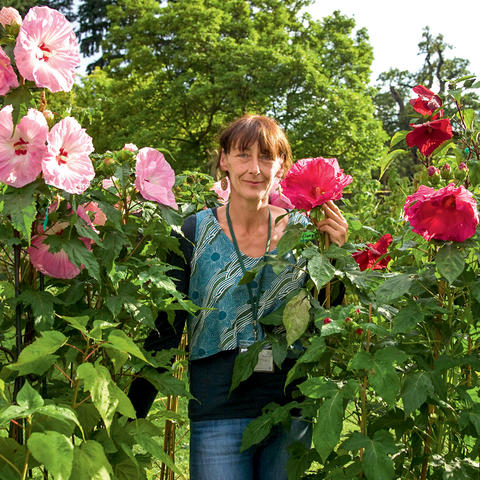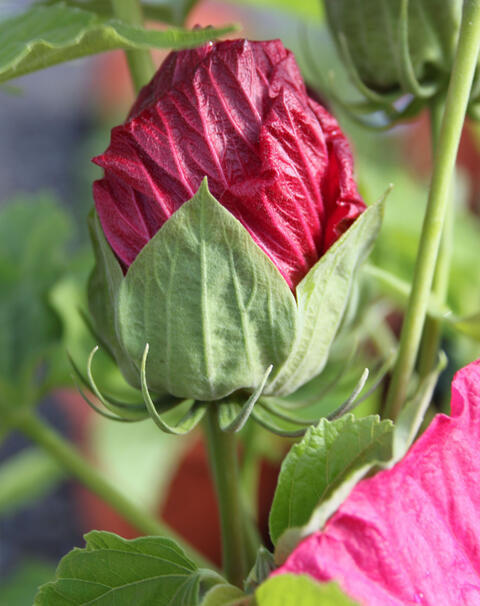Swamp Rose Mallow
When most people think of Hibiscus, they think of the exotic potted plant or the hardy flowering shrub. However, Swamp Rose Mallow is known only to a handful of gardening enthusiasts. We introduce you to the plant and explain how to grow and maintain it.
Factsheet
- Growth type
-
- Perennial plant
- Growth height (from)
- from 120 cm to 200 cm
- Growth width (from)
- from 80 cm to 100 cm
- Growth characteristics
-
- upright
- horst-forming
- loosely
- bushy
- Flower color
-
- red
- pink
- white
- Flowering time (month)
-
- July to October
- Flower shape
-
- Bells
- Leaf color
-
- green
- page format
-
- lobbed
- toothed
- oval
- roundish
- Fruit shape
-
- Capsule
- Light
-
- sunny
- Soil type
-
- sandy to loamy
- Soil Moisture
-
- fresh
- ph value
-
- neutral
- Lime compatibility
-
- lime-tolerant
- Nutrient requirements
-
- nutrient-rich
- Humus
-
- rich in humus
- Decorative or utility value
-
- Flower Decoration
- Nectar or pollen plant
- Climate zones according to USDA
-
- 4
- areas of life
-
- FR2
- B2
- Use
-
- Single position
- Planters
- Rebates
- Garden style
-
- Flower garden
- patio
- natural garden
- Pot garden
- Bee Friendly
- bee friendly plant
Swamp Rose Mallow (Hibiscus moscheutos) is still something of an insider’s tip among amateur gardeners. Amazingly, various species of the genus Hibiscus from the mallow family (Malvaceae) have been valued as garden plants for centuries. Varieties of the hardy species Rose of Sharon (Hibiscus syriacus) and the frost tender Chinese Hbiscus (Hibiscus rosa-sinensis) are particularly popular. On the other hand, Swamp Rose Mallow and its cultivars are not widely known, even though they look just as good as the previously mentioned species and are completely cold hardy to boot. With a flower diameter of up to 12 inches, they considerably surpass most other species and varieties. Its common name "Swamp Rose Mallow" is somewhat misleading: Swamp Rose Mallow needs plenty of water during the growing season, but doesn’t enjoy standing in water, especially in winter. The perennial is native to eastern North America, but, along with its cultivars, is becoming more and more widespread.
The German nursery Gärtnerei Bartels in Delmenhorst has worked with this species of Hibiscus for many years and offers many beautiful and healthy varieties. They predominantly come from the USA, where the first Hibiscus moscheutos hybrids were created in the middle of the last century by crossing different American wild species like Hibiscus coccineus, Hibiscus moscheutos and Hibiscus militaris. The nursery now breeds some of its own varieties too.

Depending on the variety, Swamp Rose Mallow reaches a height of 47 to 80 inches, and grows into a beautiful bushy shrub. The older the plant gets, the more luxuriant its flowers turn out.
Swamp Rose Mallow has dark green to green leaves that are oval-round to heart-shaped. Their edge is slightly serrated and lobed.
It’s difficult to beat the beauty of the Swamp Rose Mallow during its flowering stage. From around mid-July to the end of October, the plant is adorned with huge bell-shaped flowers with a long style protruding from the center. They are white, pink, or red and sometimes even multicolored.

After flowering, small capsules form, which contain the kidney-shaped, brown seeds of Hibiscus moscheutos.
Swamp Rose Mallow just can’t get enough sun. It needs full sun in the garden to develop a full bloom, strong leaves and to remain energetic and healthy.
As a heavy feeder, Swamp Rose Mallow needs soil that is rich in humus and nutrients. This is the case both for growing in open ground and in pots.
Plant Swamp Rose Mallow in spring. Mix the garden soil with a little compost to provide the plant with an additional supply of nutrients at the beginning and to get it off to a good start. It is advisable to put a drainage layer of sand or gravel at the bottom of the hole or planter. Leave a distance of at least 30 inches to other plants in the flower bed.
If the conditions are good, it is surprisingly easy to grow the exotic looking Swamp Rose Mallow. According to expert Beatrice Bartels, all the robust summer bloomer needs is an adequate supply of water during its growth phase. This is particularly important in June when Swamp Rose Mallow develops its buds: they soon fall off or dry out in dry conditions. Potted plants should also be fed a slow-release fertilizer in the second half of spring.

The hardy perennial can be pruned to the ground in late fall. Depending on the weather conditions, new growth reliably appears the following spring from May. Swamp Rose Mallow does not need winter protection, as it can withstand temperatures of up to -22 degrees Fahrenheit without any problems. To be on the safe side, you can put potted plants on an insulating board and cover with fleece or a similar material so that the root ball does not become too cold.
Do not divide Swamp Rose Mallow.
Swamp Rose Mallow is so undemanding and robust that it can be grown with very little effort. Whether planted in pots on the patio or in the garden: it attracts plenty of attention and provides an exotic flair during flowering. Since it grows relatively large, Hibiscus moscheutos is also suitable as a flowering, seasonal privacy screen for balconies. It is a valuable nectar and pollen plant for butterflies, bees, and bumblebees. The flowers are edible and can be used fresh in salads. But, similar to Hibiscus sabdariffa, it can also be used to make healthy tea, which is rich in Vitamin C.
The first known hybrid of the Swamp Rose Mallow was Hibiscus moscheutos ‘Lord Baltimore’ in 1950. Since then, the range has steadily increased. ‘Robert Fleming’, for example, is a variety that impresses with deep red flowers and compact growth. The dark leaves of ‘Kopper King’ contrast beautifully with their bright flowers. ‘Jazzberry Jam’ has bright pink petals and grows a good 60 inches tall. There are also a few rare Swamp Rose Mallows in market – however, these are not very easy to get a hold of and are usually only available by request. This includes ‘Tie Dye’ with tri-color pearl shimmer flowers and the pink-flowered variety ‘Party Favor’.

Swamp Rose Mallow can be propagated by seeds or from cuttings.
There is risk of root rot if the plant sits in too much water. A long-term nutrient deficiency or chlorosis can cause the leaves to become discolored, a clear sign of malnutrition. Aphids can also cause problems for the Swamp Rose Mallow. Check the plant regularly for infestations.



